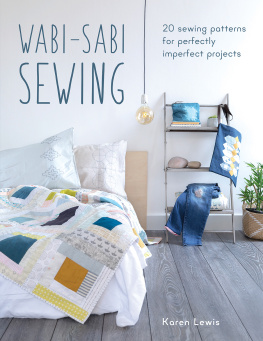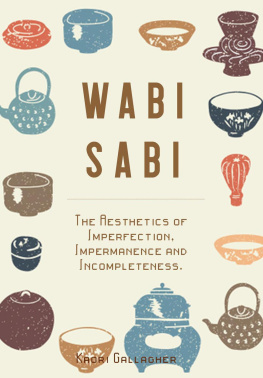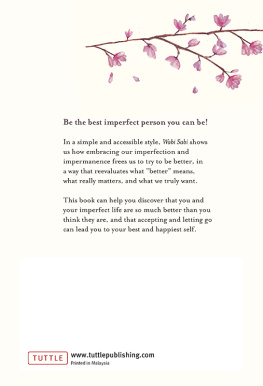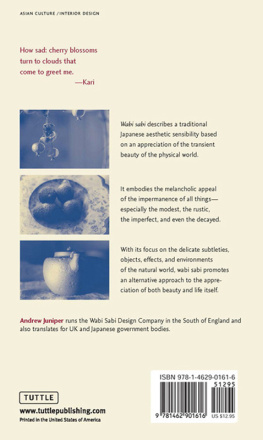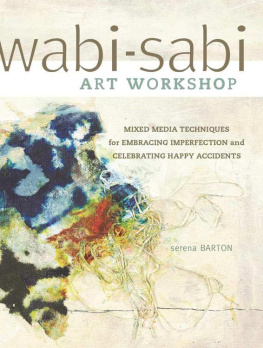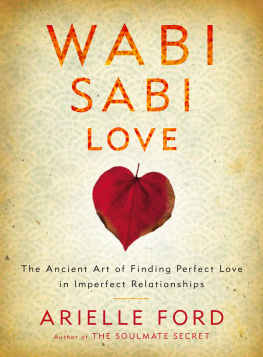Mark Bailey - Wabi-Sabi Home
Here you can read online Mark Bailey - Wabi-Sabi Home full text of the book (entire story) in english for free. Download pdf and epub, get meaning, cover and reviews about this ebook. year: 2020, publisher: Ryland Peters & Small, genre: Detective and thriller. Description of the work, (preface) as well as reviews are available. Best literature library LitArk.com created for fans of good reading and offers a wide selection of genres:
Romance novel
Science fiction
Adventure
Detective
Science
History
Home and family
Prose
Art
Politics
Computer
Non-fiction
Religion
Business
Children
Humor
Choose a favorite category and find really read worthwhile books. Enjoy immersion in the world of imagination, feel the emotions of the characters or learn something new for yourself, make an fascinating discovery.
- Book:Wabi-Sabi Home
- Author:
- Publisher:Ryland Peters & Small
- Genre:
- Year:2020
- Rating:4 / 5
- Favourites:Add to favourites
- Your mark:
- 80
- 1
- 2
- 3
- 4
- 5
Wabi-Sabi Home: summary, description and annotation
We offer to read an annotation, description, summary or preface (depends on what the author of the book "Wabi-Sabi Home" wrote himself). If you haven't found the necessary information about the book — write in the comments, we will try to find it.
Mark Bailey: author's other books
Who wrote Wabi-Sabi Home? Find out the surname, the name of the author of the book and a list of all author's works by series.
Wabi-Sabi Home — read online for free the complete book (whole text) full work
Below is the text of the book, divided by pages. System saving the place of the last page read, allows you to conveniently read the book "Wabi-Sabi Home" online for free, without having to search again every time where you left off. Put a bookmark, and you can go to the page where you finished reading at any time.
Font size:
Interval:
Bookmark:

 Wabi Sabi Home FINDING BEAUTY IN IMPERFECTION MARK & SALLY BAILEY PHOTOGRAPHY BY DEBI TRELOAR
Wabi Sabi Home FINDING BEAUTY IN IMPERFECTION MARK & SALLY BAILEY PHOTOGRAPHY BY DEBI TRELOAR 
 SENIOR DESIGNER Megan Smith SENIOR COMMISSIONING EDITOR Annabel Morgan LOCATION MANAGER Jess Walton PRODUCTION MANAGER Gordana Simakovic ART DIRECTOR Leslie Harrington EDITORIAL DIRECTOR Julia Charles PUBLISHER Cindy Richards STYLING Mark Bailey INDEXER Diana LeCore First published in 2014 as Imperfect Home. This edition published by Ryland Peters & Small 2021 Jockeys Fields, London WC1R 4BW and 341 E 116th Street New York, NY 10029 www.rylandpeters.com 10 9 8 7 6 5 4 3 2 1 Text Mark and Sally Bailey 2014, 2019 Design and photographs Ryland Peters & Small 2014, 2019 ISBN: 978-1-78879-091-8 E-ISBN: 978-1-78879-332-2 Printed and bound in China The authors moral rights have been asserted. All rights reserved. No part of this publication may be reproduced, stored in a retrieval system or transmitted in any form or by any means, electronic, mechanical, photocopying or otherwise, without the prior permission of the publisher. A CIP record for this book is available from the British Library.
SENIOR DESIGNER Megan Smith SENIOR COMMISSIONING EDITOR Annabel Morgan LOCATION MANAGER Jess Walton PRODUCTION MANAGER Gordana Simakovic ART DIRECTOR Leslie Harrington EDITORIAL DIRECTOR Julia Charles PUBLISHER Cindy Richards STYLING Mark Bailey INDEXER Diana LeCore First published in 2014 as Imperfect Home. This edition published by Ryland Peters & Small 2021 Jockeys Fields, London WC1R 4BW and 341 E 116th Street New York, NY 10029 www.rylandpeters.com 10 9 8 7 6 5 4 3 2 1 Text Mark and Sally Bailey 2014, 2019 Design and photographs Ryland Peters & Small 2014, 2019 ISBN: 978-1-78879-091-8 E-ISBN: 978-1-78879-332-2 Printed and bound in China The authors moral rights have been asserted. All rights reserved. No part of this publication may be reproduced, stored in a retrieval system or transmitted in any form or by any means, electronic, mechanical, photocopying or otherwise, without the prior permission of the publisher. A CIP record for this book is available from the British Library.  CONTENTS { textiles } { texture } { colour } { handmade } { collections }
CONTENTS { textiles } { texture } { colour } { handmade } { collections }  INTRODUCTION This book was inspired by a hand-beaten brass spoon, bought from Tokyos Mingeikan, the Japan Folk Crafts Museum.
INTRODUCTION This book was inspired by a hand-beaten brass spoon, bought from Tokyos Mingeikan, the Japan Folk Crafts Museum.  CONTENTS { textiles } { texture } { colour } { handmade } { collections }
CONTENTS { textiles } { texture } { colour } { handmade } { collections }  INTRODUCTION This book was inspired by a hand-beaten brass spoon, bought from Tokyos Mingeikan, the Japan Folk Crafts Museum.
INTRODUCTION This book was inspired by a hand-beaten brass spoon, bought from Tokyos Mingeikan, the Japan Folk Crafts Museum. Our spoon was one of a handful that were similar but also different not just useful but unique, and certainly without the flawless regularity of a machine-made object. The museums shop was no ordinary gift shop; it contained a meticulously curated collection of objects by present-day Japanese makers, including ceramics, glass, baskets, paper and metalware. The Japanese concept of finding beauty in the imperfect and embracing the humble is called wabi-sabi. It is not a decorating style, but a whole worldview. Walking through Mingeikans galleries, wabi-sabi was abundantly present, in the simple rustic shapes of early hagi ware glazed pottery or the nubbly, highly tactile cast-iron kettles. These objects seemed to have a soul, not least because their little imperfections were the result of them having been made by hand.
Returning to Japan to take photographs for this book, we found that wabi-sabi was alive and well in many Japanese homes; the frayed, the weathered and the worn are embraced, and ordinary, practical objects are given elevated status by being displayed in a wonderfully measured way. Widening our search, we uncovered homeowners all over the world who appreciate the imperfect. They have created inspiring spaces that are individual, yet share an understanding that wobbly, battered, scuffed, peeling and even broken objects are not just beautiful but preferable to pristine ones, because they bring a place to life and make it feel homely and personal. Each chapter of this book textiles, texture, colour, handmade, collections expands upon an element of the imperfect home. They consider ways to incorporate these features into your own space, and also focus more closely on a single home that encapsulates these ideas. We hope that they will inspire you to see the beauty in the imperfect.
IMPERFECT PHILOSOPHY Flawlessness is to be admired in some quarters, but it is hard to justify its place in the home. From an aesthetic point of view, rigid symmetricality and uniform textures and colours do little to stimulate the eye, or the imagination. And from a practical perspective, a pristine house will soon be subject to the ravages of daily life bumps and scrapes are inevitable, even if you are unshakeably fastidious. We believe in a looser, more relaxed approach. Were not advocating that you forget about the housework, or let your possessions pile up unhindered, but that you surround yourself with ordinary, irregular things that you love to look at. Indeed, you should welcome them in, as a way to achieve a sense of true homeliness.
This looser approach might mean finding more spontaneous ways to display art or photographs, hanging them from a bulldog clip or pinning them directly to the wall being more flexible will enable you to easily change things around if you tire of them. It might entail patching and mending your textiles, rather than throwing them away, and appreciating their idiosyncratic new look. A sense of authenticity is much easier to achieve when you choose handmade objects over machine-made ones, especially the humbler items that you touch every day, like glasses and tableware, mixing and matching them with harder-edged industrial fittings to create a pleasing contrast. When it comes to the backdrop for your objects, a calm, neutral setting will make things stand out. However, if you are lucky enough to live in an older home where surfaces have been built up successively over decades, you may well have a rich treasure trove of imperfect walls, doors and other features just waiting to be uncovered.  ORDINARY IRREGULARITY Surround yourself with things you love to look at, no matter how ordinary or irregular they might be.
ORDINARY IRREGULARITY Surround yourself with things you love to look at, no matter how ordinary or irregular they might be.  ORDINARY IRREGULARITY Surround yourself with things you love to look at, no matter how ordinary or irregular they might be.
ORDINARY IRREGULARITY Surround yourself with things you love to look at, no matter how ordinary or irregular they might be.
In the dining room of our home on the Welsh borders (opposite), chalky white walls, flagstone floors and a scuffed canteen table with a black linoleum top provide a stable, unchanging backdrop that allows us to experiment with new ways to display.  OUT IN THE OPEN Dispense with drawers and cupboards and keep your treasures out on display.
OUT IN THE OPEN Dispense with drawers and cupboards and keep your treasures out on display.  In our home, we use a galvanized metal industrial rail attached to an old French monastery bench in lieu of a wardrobe. We all delight in the unexpected, and displaying items for their patina, their silhouette or simply their craftsmanship can make you see them in a new light. Objects that are broken, incomplete or obsolete may have lost their original function, but they can still be displayed as beautiful things in their own right or, better still, given a new life. Reusing things will not only challenge your creative skills, but makes for a thrifty approach too.
In our home, we use a galvanized metal industrial rail attached to an old French monastery bench in lieu of a wardrobe. We all delight in the unexpected, and displaying items for their patina, their silhouette or simply their craftsmanship can make you see them in a new light. Objects that are broken, incomplete or obsolete may have lost their original function, but they can still be displayed as beautiful things in their own right or, better still, given a new life. Reusing things will not only challenge your creative skills, but makes for a thrifty approach too.
Font size:
Interval:
Bookmark:
Similar books «Wabi-Sabi Home»
Look at similar books to Wabi-Sabi Home. We have selected literature similar in name and meaning in the hope of providing readers with more options to find new, interesting, not yet read works.
Discussion, reviews of the book Wabi-Sabi Home and just readers' own opinions. Leave your comments, write what you think about the work, its meaning or the main characters. Specify what exactly you liked and what you didn't like, and why you think so.




